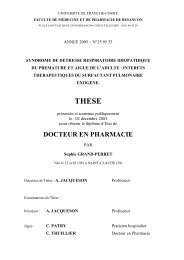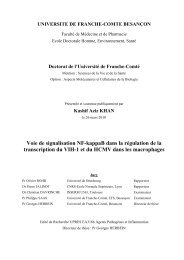THÈSE - Université de Franche-Comté
THÈSE - Université de Franche-Comté
THÈSE - Université de Franche-Comté
You also want an ePaper? Increase the reach of your titles
YUMPU automatically turns print PDFs into web optimized ePapers that Google loves.
wildlife by trampling, thus disturbing voles by soil vibrations. Ploughing and harrowing turn<br />
over the first centimetres of soil at a <strong>de</strong>pth of 30 and 5cm, respectively. These actions could<br />
<strong>de</strong>stroy vole galleries (Kopp 1993) and plant supply (Jacob 2003). The <strong>de</strong>struction of<br />
vegetation shelter by grass browsing (Schmidt & Olsen 2003) or by soil work (White, Wilson<br />
& Horskins 1998) exposes voles to predation and their ground habitat to <strong>de</strong>hydration by<br />
increasing the surrounding temperature (Kopp 1993).<br />
More specifically, trampling by cattle may also slow down soil prospecting by voles and plant<br />
roots (vole principal food source) by compacting the soil. However, only intensive pastures<br />
presented significant lower relative abundance of A. terrestris. This suggests that the intensity<br />
and duration of this farming practice had a disturbing effect on voles (Jacob 2003). It may also<br />
explain why we did not find a negative impact of grazing in the study at the low <strong>de</strong>nsity phase<br />
and the increase phase of the A. terrestris cycle. In<strong>de</strong>ed, the sample sites did not inclu<strong>de</strong><br />
intensive pastures but only typical parcels un<strong>de</strong>r the forage production system.<br />
Concerning soil work, machinery could have a direct lethal effect (Jacob & Hempel 2003). A<br />
significant difference of A. terrestris relative abundance was <strong>de</strong>tected between ploughed and<br />
harrowed parcels. This suggests that the negative effects of soil work increased with the <strong>de</strong>pth<br />
of the practice. However, this study was conducted in the same year as soil work application<br />
(Table 2) and soil turn over constituted a temporary disturbance. In<strong>de</strong>ed, it is important to<br />
keep in mind that the negative effect of soil work could become positive after germination and<br />
growth of the sown vegetation because the soil may become more prospectable for voles and<br />
plants (Meylan & Höhn 1991). Jacob & Halle (2001) and Jacob (2003) thought that annual<br />
elimination of voles by ploughing, must be followed by immigration from adjacent refuges to<br />
recolonise the <strong>de</strong>vastated area, thus suggesting the importance of long-term studies on the<br />
impact of farming practices. This was also previously illustrated by the difference between the<br />
short-term negative effects and the long-term positive effects of mowing. Further research is<br />
now required to investigate the long-term effects of soil work, although initial work by<br />
Giraudoux et al. (1997) showed that, at a regional scale, areas, which are composed of an<br />
appreciable ratio of ploughed parcels to agricultural land (>15%), were less susceptible to<br />
population outbreaks.<br />
Thèse C. Morilhat 2005 108









